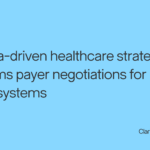Today’s healthcare providers are seeing significantly more patients than they did a decade ago – many of whom are often sicker and have more complex care needs. This increase can be attributed to many things, including an aging population, the increasing prevalence of chronic conditions, and greater access to care stemming from expanded insurance coverage. These patients have evolving and growing needs and expectations for the quality of care delivered and overall patient experience. To succeed in this evolving healthcare landscape, health systems and providers must carefully evaluate expansion opportunities and explore potential partnerships as part of a robust growth strategy. Meeting these needs and developing a roadmap for growth is challenging, and mergers and acquisitions can be an important way to increase access to care, boost quality, and relieve financial pressures. According to the American Hospital Association, research shows that healthcare mergers and acquisitions can reduce inpatient readmission rates and improve health outcomes by expanding access to an integrated care network. But consolidation in healthcare markets is not with its critics, with some experts raising concerns over increasing prices due to decreased competition and eliminating services. There is division in the healthcare industry over the pros and cons of healthcare mergers and acquisitions. But healthcare groups, including the American Hospital Association, continue to assert that they reduce costs. A Health Affairs study from 2022 also found that private equity acquisitions drove higher operating margins and decreased discharge costs. In addition to lower costs, other ways healthcare mergers and acquisitions benefit patients include: Like so many healthcare-related issues, for every proponent of mergers and acquisitions, there are detractors, those who express significant concern about negative impacts on practice and provider management and patient care quality. The diminished market competition resulting from mergers is at the forefront of those concerns. When patients have fewer options for healthcare services, hospitals have the power to charge higher prices for their services and negotiate for higher prices from health plans. With higher price tags, the incentive for quality improvement is lower, setting back efforts to drive value-based care. This limited choice can also lead to fewer choices for patients when a merger or acquisition results in there being a dominant provider in a region. Sometimes, mergers and acquisitions disproportionately focus on profit, which can unfortunately lead to the prioritization of financial interest over patient care. While value-based care models undoubtedly support provider growth, the focus on quality and efficiency inherent in such models can get lost in discussions of overall profitability and cost-cutting measures that lead to the closure of less profitable services or facilities. Moreover, while there are benefits to larger health systems acquiring smaller systems in terms of access to resources, they can sometimes result in providers feeling less connected to the decision-making process and patients losing out on the local feel and comfort of their local facility. Along with that loss of familiarity comes integration issues as two or more organizations attempt to integrate data, like electronic medical records, and bring all entities together on the same technology, a process that can be complex at best and disruptive or ineffective at worst. Patients today are demanding more from their healthcare experience and are willing to walk away when a provider or hospital fails to meet their expectations. Healthcare mergers and acquisitions can provide hospitals with the resources, services, and technology to meet the needs of their patients, allowing them to focus on long-term growth while also managing costs. Because not all mergers and acquisitions are the same, it is vital that hospital executives carefully and strategically consider merger and acquisition opportunities, seeking those that have the greatest potential to increase access and improve patient care. Finding potential partners who share your mission, vision, and goals and who can help you fill financial and outcomes gaps, while not always easy, will pay dividends in the long run for your bottom line, your staff, and, most importantly, your patients.How do healthcare mergers and acquisitions benefit patients?
Drawbacks to healthcare mergers and acquisitions
Conclusion
- Author Details





